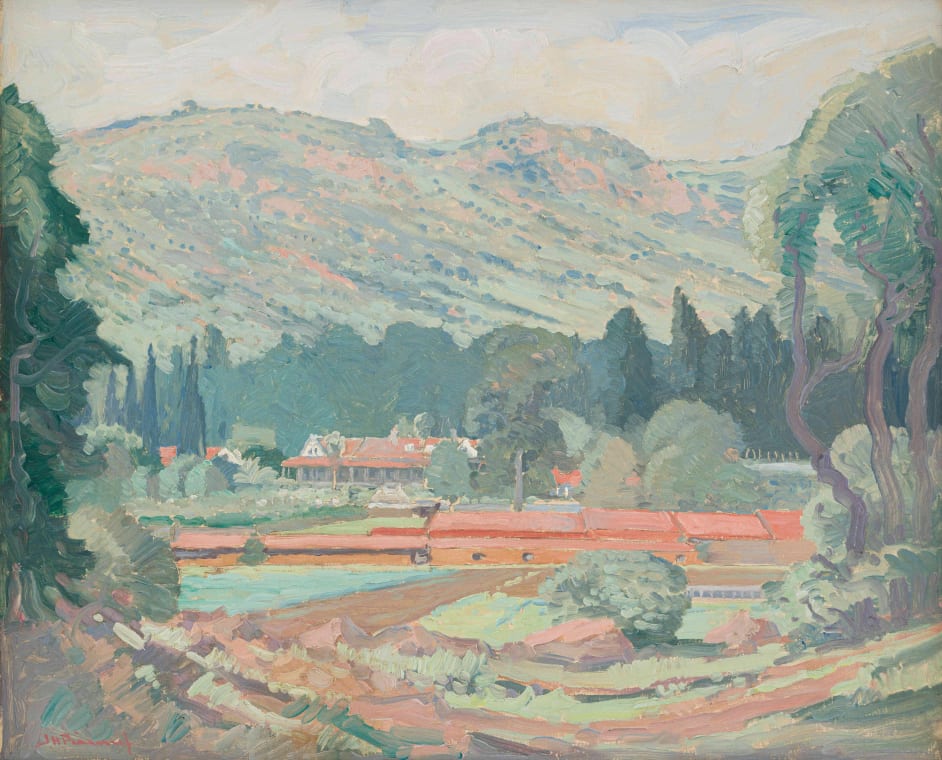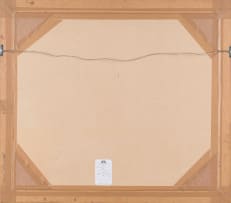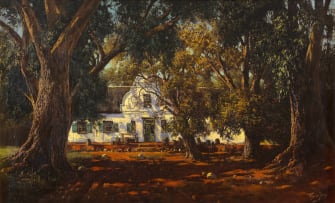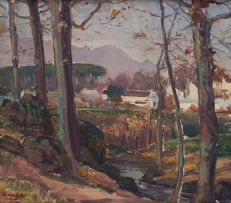Modern, Post-War and Contemporary Art
Live Virtual Auction, 17 - 18 May 2021
Modern, Post-War and Contemporary Art
Incl. Buyer's Premium & VAT
About this Item
signed
Notes
Henk Pierneef returned from his European travels early in 1926. Riveted and inspired by various modernisms, the immediate work he produced back in Pretoria was thrillingly radical: he re-imagined his beloved landscapes according to shard-sharp geometric principles, and enlivened them with a startling, fauvist palette. He also experimented with a personal brand of divisionism, building up an impressionistic effect on his canvas with flashy, expressive daubs of pure colour. While paintings from this period are now fabled and impossibly rare, they were unpopular sellers at the artist's exhibitions from 1926 to 1928. Having to face up to commercial realities, by the end of the decade the artist reverted to his more familiar, monumental, and pleasingly linear aesthetic. This stylistic doubling back - his return to order - was also necessitated by a landmark commission he received in July 1929 to paint decorative and grand landscape panels for the newly-built Johannesburg Railway Station.
Pierneef ultimately painted twenty-eight landscapes to decorate the station's main concourse. Criss-crossing the country, he chose beautiful and prominent destinations that could be reached from the city's impressive new transport hub. The breadth of concept, the stylistic harmony, the propaganda power, and the sheer decorative impact of the paintings arguably position the group as the most important state or parastatal commission in twentieth-century South Africa.
The present lot, which shows an old, stone and red-roofed Transvaal house, is one of the very rare oil studies related to the Station commission. Painted quickly, with confidence and swagger, the surface has a gorgeous and swirling arrangement of olive and lime green, across which cuts streaks of pink, brown and terracotta. The painting is the precursor of the famous Klipriviersberg, Alberton panel (fig. 1). The same stables, pavilions and outbuildings are clear in the study, although captured with looser and more spontaneous brushstrokes. This treatment, frankly, is reminiscent of his more successful post-European experiments with divisionism. There are a number of familiar Pierneef design traits here: Henk shaped the landscape in the foreground to create a gentle curving line at the base of the composition, inverting the form at the top with the rounded hilltops and clouds; he also positioned tall trees at the edges of the picture - like columns or stage curtains - to best frame the view towards the old farmhouse, nestled in the treeline.
What is rather special about this farmhouse is that Henk knew it intimately. He was friends with the Meyers - the owners - whose voortrekker family had established the farm in the 1840s. There are records of the artist working at the Meyer farm in the early 1920s - that he should return to the scene for his most important commission is heart-warming indeed. The Klipriviersberg, Alberton panel, incidentally, was positioned in the north-west corner of the Station's main concourse, between the Amajuba and Houtbos, Transvaal panels.
Provenance
PL Meyer, and thence by descent.
Exhibited
PG Nel (1990) JH Pierneef: His Life and Works, Johannesburg: Perskor, illustrated in colour on pages 40 and 41.
View all Jacob Hendrik Pierneef lots for sale in this auction













